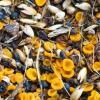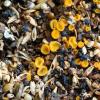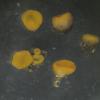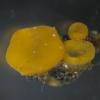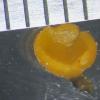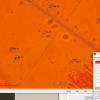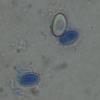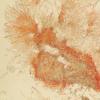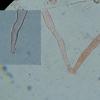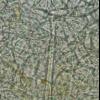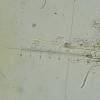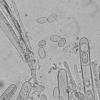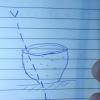
12-11-2025 09:25
 Viktorie Halasu
Viktorie Halasu
Hello, I need help with a pale terrestric Pseudom

11-11-2025 20:16
Bohan JiaHi, lastly I have found these tiny yellow decayin

09-11-2025 13:20
Hello.A tiny ascomycete, appearing as erupting gra

08-11-2025 00:29
 Francois Guay
Francois Guay
I found this species in Quebec, Canada, on herbace
Cheilymenia (?) on bird bedding with seed husks and likely excreta
Stephen Martin Mifsud,
15-12-2021 16:24
 I am struggling with this Cheilymenia and I cant even decide the section using Moravec's (2005) keys.
I am struggling with this Cheilymenia and I cant even decide the section using Moravec's (2005) keys. The Apothecia were clustered, 3-5mm on seed husks and possibly excreta probably of some exotic cage bird dumped on soil (are there also burnt elements ?)
First of all I cant see any striations in the ascospores, evenat x630 stained in cotton blue. Their size is about 17 x 10 um. The asci have h-shaped or boot-heel shape, 8-spore, J -ve. The hairs are septate (x1 - x2) thickwalled and with a lateral bulbous base (a bilbous structure at one side of the hair), the longest about 220 um long, hyaline, barely visible with naked eye.
The texture of the medullary excipulum is globose (to prismatic) but I cant see textura intricata.
The paraphyses are only slightly enlarged at the apex.
There are also infalted hyphae about 25 um long sitting on narrow hyphae.
I made my mind on Cheilymenia theleboloides s.l. , but these should have striated spores ?!?!
Stephen Martin Mifsud,
15-12-2021 17:15

Re : Cheilymenia (?) on bird bedding with seed husks and likely excreta
Cheilymenia theleboloides f. glabra is my best or favourite option. But if spores are smooth I am clueless.
Peter Püwert,
16-12-2021 00:55
Re : Cheilymenia (?) on bird bedding with seed husks and likely excreta
Hi, I have seen striate spores only in a very mature state. The substrate seems to prefer this species. (Look the photos in the Link) Regards Peter.
Charles Aron,
16-12-2021 10:48

Re : Cheilymenia (?) on bird bedding with seed husks and likely excreta
Hi Stephen and Peter,
I also had this species on what looked like old dung. You IDed it for me, Peter. I was confused because i could not find hairs but in other respects it agreed with theleboloides so I also concluded that it was the f. glabra.
Charles.
Stephen Martin Mifsud,
17-12-2021 10:47

Re : Cheilymenia (?) on bird bedding with seed husks and likely excreta
Thanks dear friends. I realise that the striations are incredibly fine from the link. So we can assign this population to C. t. f. glabra. Indeed the hairs are easily missed Charles.
The best thing to do is to prepare a slide specifically for examination of hairs. So, when you slice a section, you try to get the outer layer of the cup (from hymenium margin sliced down to the base) and avoiding the hymenium and axcipulum medulla (difficult on a 2mm ascocarp!) Observing cross-sections of the ascocarps result in only 10% of the material which may possess hairs, and being not so dense chances are to miss them.
I prepared a non-Picasso diagram ;-)
The best thing to do is to prepare a slide specifically for examination of hairs. So, when you slice a section, you try to get the outer layer of the cup (from hymenium margin sliced down to the base) and avoiding the hymenium and axcipulum medulla (difficult on a 2mm ascocarp!) Observing cross-sections of the ascocarps result in only 10% of the material which may possess hairs, and being not so dense chances are to miss them.
I prepared a non-Picasso diagram ;-)
Charles Aron,
17-12-2021 14:57

Re : Cheilymenia (?) on bird bedding with seed husks and likely excreta
Hi again,
Many thanks for your advice. I did, in fact, use that technique to look for hairs but failed to find any.
Charles.

